What color were Neandertals?
Even with whole genomes, scientists can't say very precisely what pattern of skin, hair, and eye pigmentation was in ancient populations like the Neandertals.
Source: John Hawks
Photograph: A collage of Neandertal faces as imagined by artists and exhibited in museums during the genome era. Artists include Alfons and Adrie Kennis, John Gurche, Elisabeth Daynès, Tom Björklund, Oscar Nilsson, and Fabio Fogliazza.
When I was first able to look at DNA data from Neandertal genomes in 2010, one of the first things I looked for were alleles related to pigmentation traits in living people. I was far from alone. Lots of other geneticists, including the very smart scientists on Svante Pääbo's research team who obtained the sequences in the first place, were looking at those genotypes.
Most of us had a pretty strong idea of what the genotypes would look like. Neandertals should not have many of the alleles associated with light pigmentation in today's people.
By 2010 it was clear that many genetic variants that are strongly associated with pigmentation variation in living people are newcomers in our evolution. My own research provided some of these findings, showing that positive selection in the ancestors of today's European and East Asian populations had affected many genes, including some involved in pigmentation. Those changes were mostly after 30,000 years ago, after the Neandertals were gone. So it was logical to expect that they wouldn't be in the Neandertal genomes.
Indeed, they weren't. For example, in 2012 Caio Cerqueira and coworkers presented a survey of the genotypes of more than a hundred genetic polymorphisms thought to be associated with pigmentation of hair, skin, and eyes in the known Neandertal and Denisovan genomes. Basically, they took the results of other studies that had looked for associations of single nucleotide polymorphisms (SNPs) and pigmentation phenotypes. They found that the known Neandertal genomes had very few SNP alleles associated with light pigmentation in today's people. They suggested that Neandertals had been dark-skinned, brown or red-haired, and brown eyed.

Painting by Zdeněk Burian (1960), The Neanderthal Encampment
But that was far from the end of the story. It's true that many of the DNA variants that make a difference to pigmentation today arose recently, and some of those were positively selected. But as it turns out, genes involved in pigmentation have more variants than we used to think, and indeed some of them did come into human populations from Neandertals. Neandertals also had other sequence changes that may have affected their pigmentation, but that did not come into any recent people that we know about.
All in all, the picture is complicated. If somebody asks me today, “What color were Neandertals?”, my answer is I'm not sure. The science has a long way to go. But if I were to bet on one thing, it's that they varied a lot, maybe in ways that we don't see in today's people.
The eye of the artist
For more than a hundred years, scientific illustrators have depicted ancient hominins with the same pigmentation as present-day people who live in the same part of the world.
Almost every artist who has imagined the life appearance of Neandertals has pictured them with light skin pigmentation, similar to present-day European people. They likewise imagined that the range of hair and eye color for the Neandertals would have been similar to today's Europeans, that is, Europeans who lived and worked outdoors with natural tanning.

Charles Knight's 1920 painting, “Neanderthal Flintworkers, Le Moustier Cavern, Dordogne, France”. Image: American Museum of Natural History
Fewer artists have depicted the life appearance of the Neandertals from Israel, Iraq, or other parts of central and western Asia. But those few have generally given the Neandertals dark hair and medium-light skin tones similar to peoples of western Asia today.
Illustrators and artists have expressed the ideas of scientists of their era. Most have started from the assumption that natural selection has optimized the level of pigmentation in today's people, fitting them to their local environments. The biggest reason why populations today differ in skin pigmentation is because they live in places with different exposure to ultraviolet radiation from the sun. Lighter populations live at higher latitudes where ultraviolet light is lower. In recent years, most anthropologists have accepted that the distribution of pigmentation in living people reflects a trade-off between the varied effects of ultraviolet radiation on humans. High UV radiation causes cellular damage, sunburn, increased susceptibility to water loss and infection, skin cancer, and a loss of folate. But UV radiation is necessary for synthesis of vitamin D in the skin. Seasonal variation in UV and diet both introduce complexity into this simple trade-off, and adaptations like tanning may buffer variation in environmental UV.
So scientists assume that if light pigmentation has been helpful for survival and reproduction in recent Europeans, then probably it would also have been equally valuable for Neandertals living in the same places.
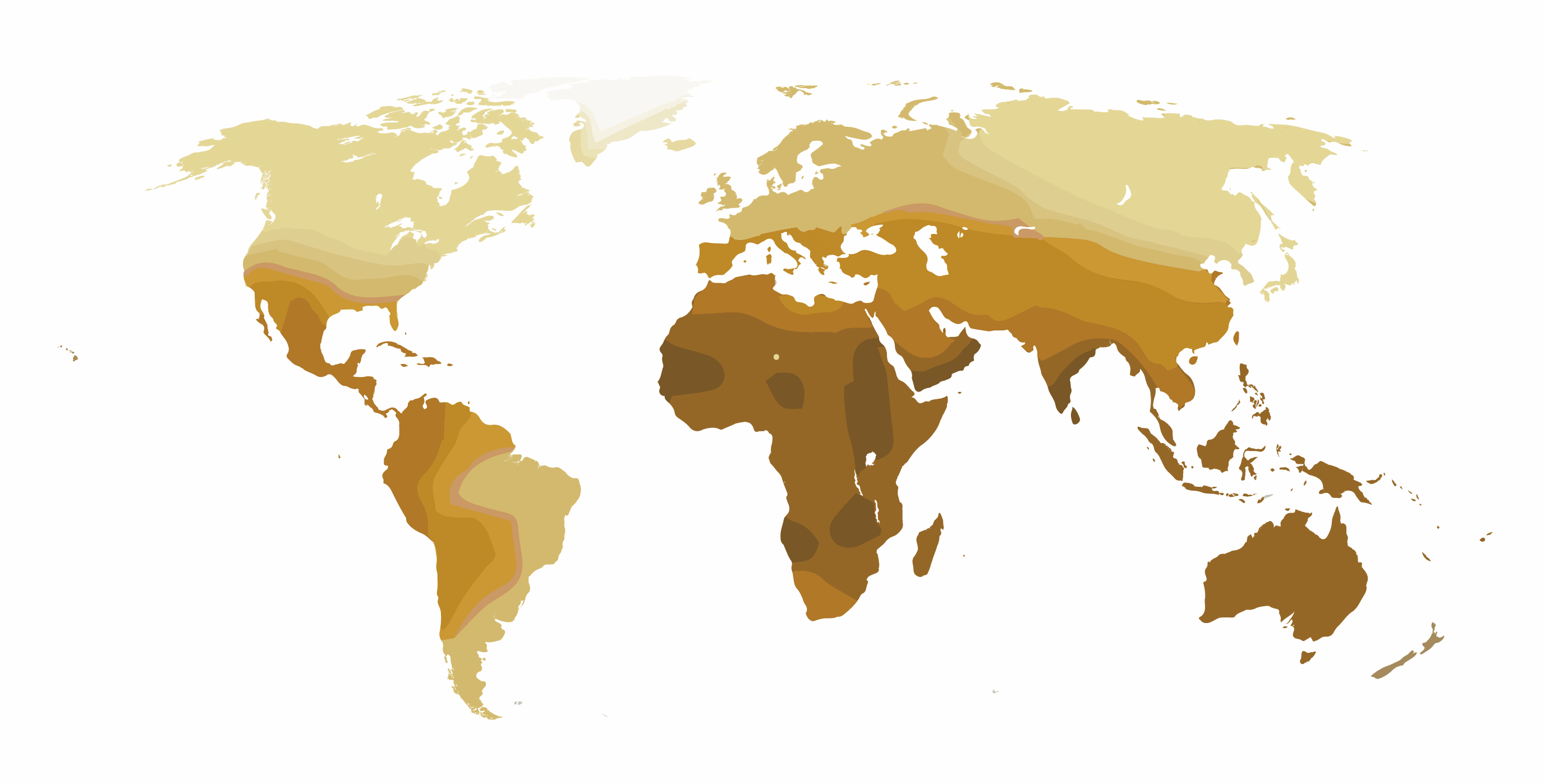
Average skin pigmentation in Indigenous peoples around the world.
Mostly scientists and artists apply the same assumption to ancient remains throughout the world. Ancient fossils from equatorial Africa are reconstructed with dark skin, hair, and eye pigmentation, while the Denisovans—mostly known from genome evidence found in Central Asia—have been depicted with pigmentation similar to present-day people of northern China and Mongolia.
These artistic traditions started long before anybody knew about the genetics of pigmentation. They were constant through back-and-forth pendulum swings about whether Neandertals were ancestors of today's people or not. Even scientists who thought that Neandertals became completely extinct and contributed no genes to later humans still thought they were probably light-pigmented, expecting convergent evolution in the same conditions of ultraviolet radiation.
So really, new genetic knowledge hasn't changed artists' work very much. But there is one exception: red hair. There's a story behind that.
Red-headed Neandertals
The first scientific shift in ideas about pigmentation in Neandertals came in 2000, when Rosalind Harding led a team of geneticists studying the gene MC1R. Human populations today have several sequence variants of this gene, and some of the variants are associated with reddish hair pigmentation. Harding and collaborators tried to estimate how long ago some of these functional variants had first arisen in MC1Rby building a tree of sequences from a sample of Europeans. They suggested that one of the variants associated with red hair in today's people had first arisen more than 80,000 years ago. With a date so long ago, and current high frequencies in Europe, Harding and coworkers suggested that the variant had come from Neandertals.
This study launched the idea that Neandertals may have had red hair. Every museum urgently needed a red-headed Neandertal, it seemed. But later work questioned the conclusion. Estimating the age of the haplotype by its frequency and place on the tree, as Harding and collaborators had done, was ignoring the substantial likelihood that natural selection had raised its frequency. In the end, this allele hasn't been seen in Neandertal DNA at all.
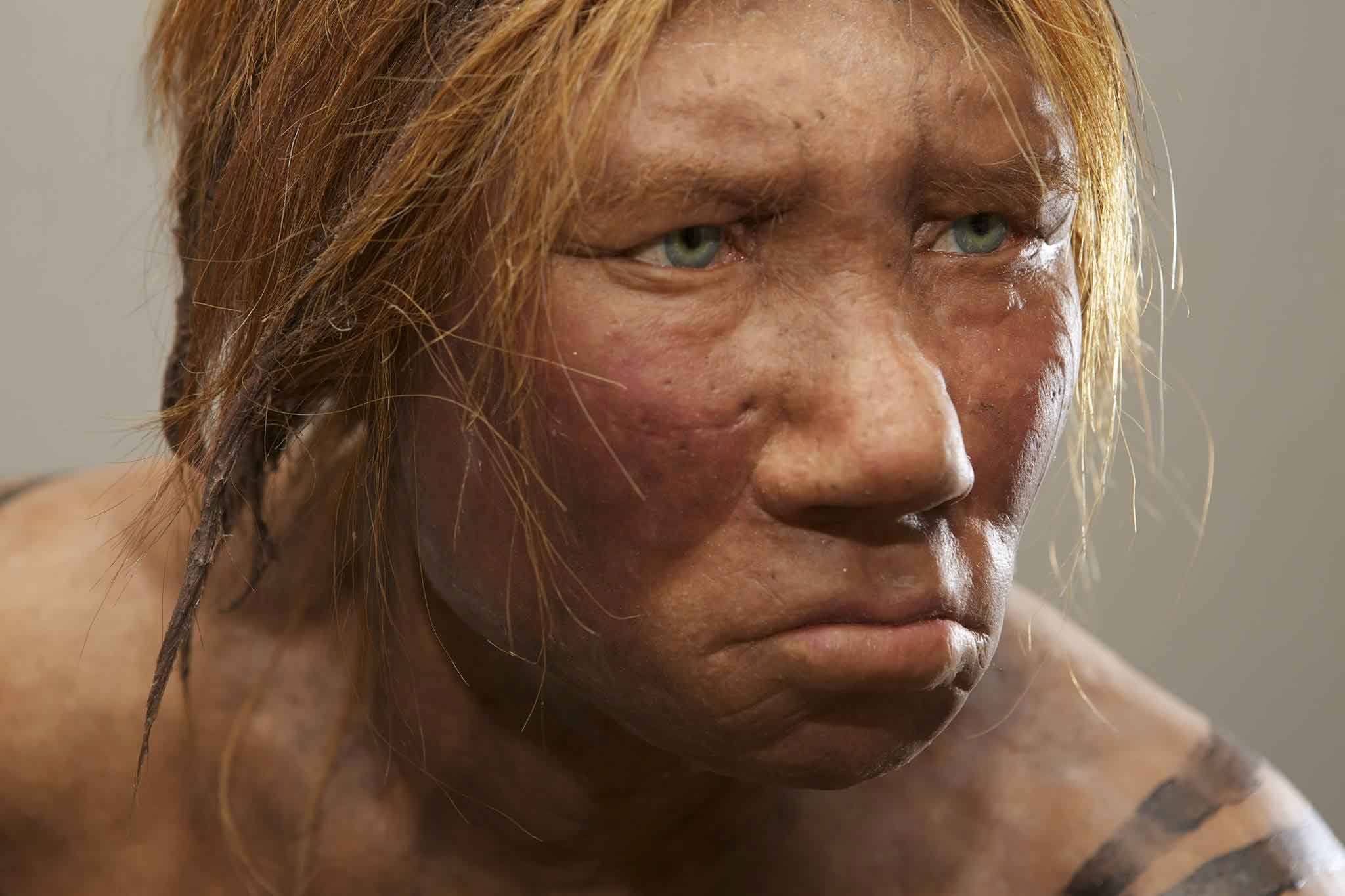
Closeup of the “Wilma” Neandertal life rendering by Alfons and Adrie Kennis, depicted with red hair, light skin, and blue eyes. Photo: National Geographic
In 2007 the story got a reboot, on a more solid basis. Carles Lalueza-Fox and coworkers found a previously-unknown variant in the MC1R gene of two Neandertal individuals from Spain and Italy. This wasn't an allele found in any recent people, so it was not possible to know directly how it may have mattered to Neandertal pigmentation. But this “R307G” variant changed an arginine to glycine in the protein sequence of the gene, and this was predicted to reduce the gene's function—an effect similar to the variants in humans that are associated with red hair. Lalueza-Fox and colleagues suggested that the Neandertals who carried the variant would be more likely to have reddish hair and lighter skin pigmentation. Again, the result suggested red-headed Neandertals.
In the years since 2007, scientists have sequenced DNA from other Neandertals from Europe and Central Asia, and have not found any more with the same R307G variant. Lalueza-Fox and collaborators may have provided the first evidence that Neandertals had varying pigmentation. However, that's not where the MC1R story ends. Some people today do have MC1Rfrom Neandertals, and it doesn't make their hair red.
Introgression of pigmentation variants
The fact that people today have Neandertal DNA makes it possible to look at living people and see what some genes from Neandertals actually do. Since we know that selection has affected pigmentation traits in many populations, this an especially interesting system to look for possible effects of Neandertal introgressed genes.
It's far from a trivial task. Finding that people today have Neandertal ancestry came from a simple count of derived SNPs across the genome, which could be accomplished with low-coverage, noisy data. Proving that any single haplotype came from Neandertals requires high-coverage genetic data, which we only have for a handful of skeletal remains. Working out possible functions of such a haplotype also requires vast samples of genomes from living people who have volunteered information about their own phenotypes.
An early foray into Neandertal functional genetics looked at a haplotype spanning MC1R. Qiliang Ding and coworkers identified a haplotype from the Neandertal genome from Denisova Cave, the so-called Altai Neandertal, that today is common in some indigenous peoples of Taiwan and less common but present more broadly in East Asia and Melanesia. This haplotype does not have the R307G variant that spurred the “red-haired Neandertals” idea, but it does have a coding change at position 92 from a valine to methionine, V92M. This variant has been studied in many living populations because it is predicted to decrease the gene response, but few have found clear associations with pigmentation. One notable result was an association with increased freckling in Japanese research participants.
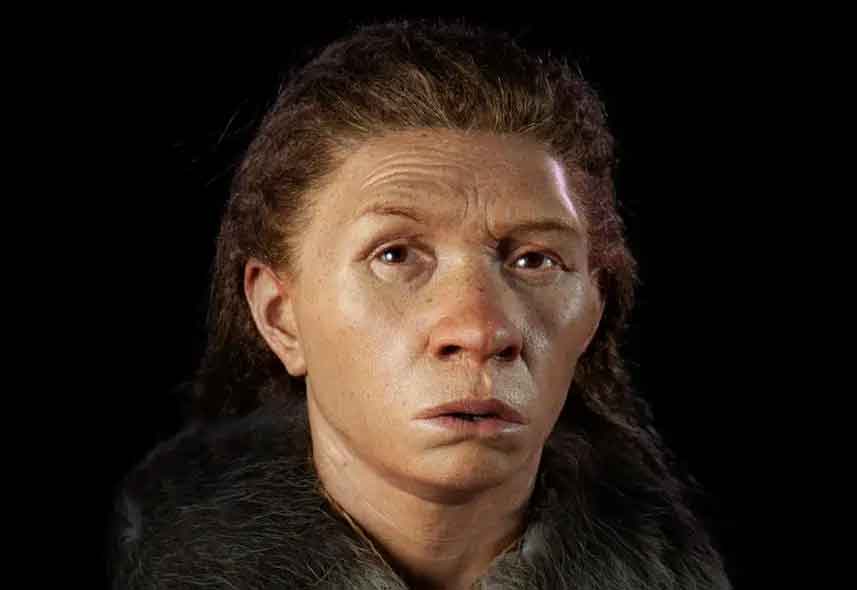
Reconstruction of a Neandertal by the forensic artist, Oscar Nilsson, showing freckles. Image: Royal Pavilion & Museums, Brighton & Hove.
Later work led by Joshua Akey's research team extended the search for introgressed haplotypes genome-wide. In 2016, Rachel Gittleman and coworkers showed that two Neandertal introgressed haplotypes involved in pigmentation are today very common in human populations, again suggesting a history of selection.
One of these haplotypes included the gene OCA2, which is well known to have several variants in living people associated with skin and eye pigmentation. It is most commonly mentioned as a genetic association with blue versus brown eyes. One haplotype spanning the OCA2 gene that is common today came from Neandertals. The introgressed haplotype has its highest frequencies, more than 60%, in East Asian populations. That's way higher than the 2% average Neandertal genetic ancestry, which suggests that natural selection increased these haplotypes in past populations. This haplotype occurs in other populations also, with Melanesian and South Asian population samples around 35 percent and Europeans around 30 percent.
This Neandertal haplotype that spans OCA2is a great example for how challenging it can be to work out the functional importance of introgressed haplotypes. This haplotype has no coding variants. So if there are functional differences between this haplotype and others, they must involve gene regulation and not gene structure. The haplotype has dozens of SNP variants but only one had been flagged in previous studies of pigmentation. This one has an association with eye color and hair color in European ancestry samples, which is statistically significant but small in effect. Because it does not strongly predict eye or skin color, it is uncertain whether some other linked variant may be the cause of the association. Frustratingly, there has been no recent work showing what effects it may have in people beyond European ancestry—who are much more likely to have the Neandertal haplotype.
I think most people imagine that you could point to a variant like this and predict that it will change skin or eye color by a known amount. But the biology doesn't work that way. It is a good hypothesis that this variant may have lightened pigmentation in the Neandertal individuals who carried it, but how much and in what pattern we cannot say for sure.
The other gene involved in pigmentation that Gittleman and coworkers identified is BNC2. This introgressed haplotype has a frequency of around 70% in European population samples and is rare elsewhere. Later work by Michael Dannemann and Janet Kelso found that this was just one of two BNC2haplotypes from Neandertals in the UK Biobank sample. The first, more common one at around 69 percent, is associated with greater susceptibility to sunburn and reduced tanning in people who carry it. The second, around 19 percent frequency, is associated with darker skin pigmentation.
This result is the mirror image of the OCA2haplotype. It would seem like a good hypothesis that these variants of BNC2 may have darkened pigmentation in some Neandertals, reduced tanning in others. When you add these results together, you can see that this approach doesn't lead to an easy answer.
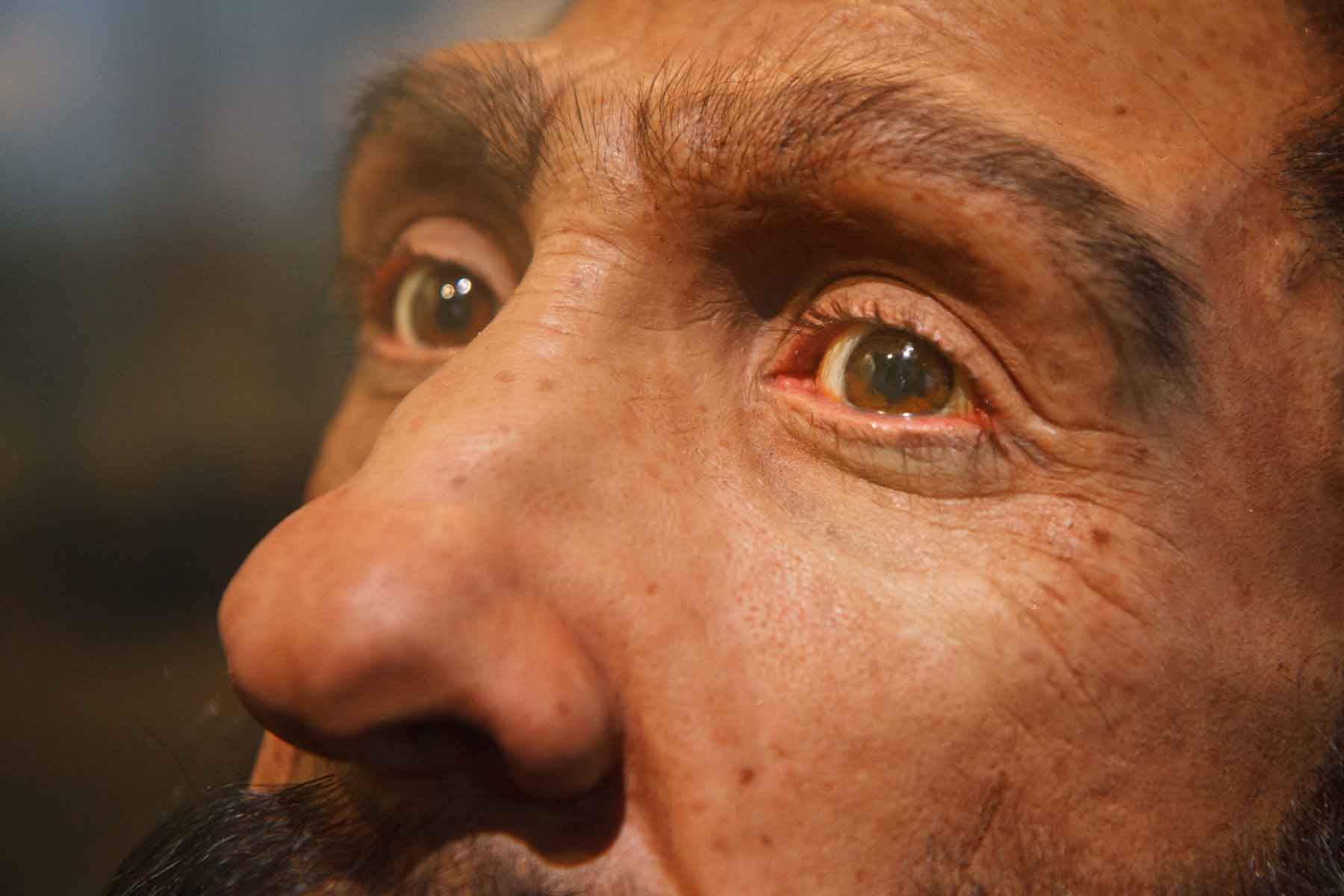
Reconstruction of the Shanidar 1 Neandertal by John Gurche at the National Museum of Natural History. Photo: Adam Gordon (Flickr)
So, what color were they?
In Jurassic Park, the geneticist Henry Wu famously solved the problem of gaps in ancient dinosaur genomes by filling them in with frog DNA. To make functional chromosomes this is a real challenge. The scientists working to complete mammoth genomes plan to fill in structural gaps with elephant DNA.
But gaps in the data are not the problem here. When it comes to our ability to look at SNP genotypes, we have as complete knowledge of some Neandertals as we do for living people.
With so much information, it's disheartening how few solid results there are. Neandertals did have some variation in genes related to hair, skin, and eye pigmentation. Some of that variation has been inherited by today's populations, and different variants are more or less common in different populations. More of the introgressed variants are associated with lighter pigmentation than darker.
Neandertal genes have little to do with the variation that we see among people today. The strongest associations of genetic variants with pigmentation in northern Eurasia are for variants Neandertals never had. Our knowledge is continuing to grow with genetic surveys of populations from Africa, southeast Asia, and Oceania, all of which have genetic variants associated with pigmentation, but only a few of which introgressed from Neandertals. Today we know of more than a hundred variants associated with pigmentation variation in living humans. Fewer than ten of these are known for Neandertals. Our thin current knowledge may not be representative of the wider picture.
Our guesses about what Neandertals looked like are stuck with what people have thought for more than a century. The most northern Neandertals in central Asia and Europe probably had less melanin in their skin, resulting in lighter pigmentation, than the other ancient people who lived closer to the equator. It stands to reason that lighter pigmentation would be adaptive for them, for the same reason it is in recent people.
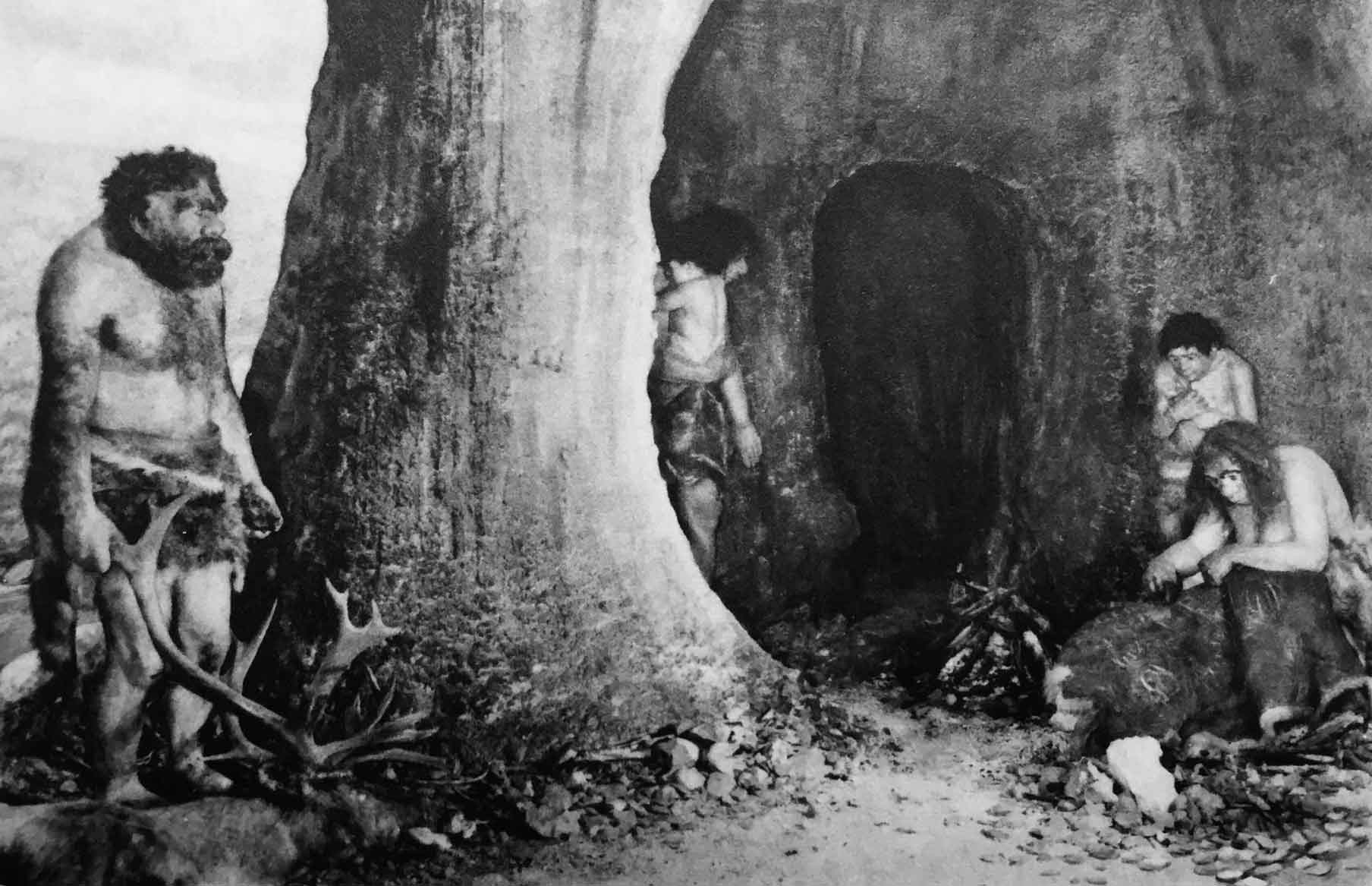
Diarama showing Neandertals from the 1930s at the Field Museum of Natural History, based on sculptures by Frederick Blaschke. Image: Field Museum
But I doubt that is the end of the story.
What I come back to is Henry Wu from Jurassic Park. We don't have to fill in Neandertal genomes with human DNA. But from the first discovery of the Neandertals, scientists have papered over the gaps in our knowledge about them by filling in details from living Europeans. Look at the paintings of Zdeněk Burian or Charles Knight, or the famous dioramas from the Field Museum by Frederick Blaschke. Their Neandertals look sad and dishevelled with shreds of fur around their loins, smudged with dirt and charcoal, stripped of all but the barest rudiments of material culture. But give them a shave and shower and these Neandertals had soft tissue anatomy, hair patterning, and pigmentation that would fit into a modern European city.
Depictions from the last twenty years are superficially quite different from the plodding cavemen of the past. Artists have granted them a dignity of posture. They wear ornaments, paint, or feathers, and their fur clothing has better tailoring. From young children to weatherbeaten adults, they are sometimes seen to smile. But the gaps still are filled with European norms, from skin and eye color, hair texture and color, and beard patterning, to features like eyelid shape and lips.
It's ironic that so many anthropologists ask the question, would a Neandertal dressed in modern clothing be noticed on a bus or subway in a city? If we limit our imagination to Neandertal life reconstructions in major museums, the answer in London, Berlin, or Barcelona might well be no. Aside from the browridge, the Neandertals could fit right in. But in Jakarta, Manila, or Beijing—all places where the proportion of Neandertal ancestry today is as high or higher than in Europe—the answer might be yes. The Neandertals might stick out from the local crowd, not because they look like Neandertals, but because they look European.
That's not because we have scientific evidence that Neandertal soft tissue facial anatomy, hair patterning, or even pigmentation were like today's Europeans. It's because scientists and artists for a century have seen them through a Eurocentric lens.
Seeing Neandertals anew
The science constrains the appearance of Neandertals and other ancient people in certain ways. Their skeletons show that they adapted to physical environments in humanlike ways, including evolution of their body shape and size, and cultural strategies involving fire use, plants used for bedding, and animal skins for clothing. Skin pigmentation would have been part of their physical adaptation, and we have some evidence from their genomes that they did indeed vary.
But much of human variation today is notadaptive, or at least not strongly constrained by physical environments. Faces, hair texture and patterns, eye shapes and iris pigmentation, patterns of wrinkling and graying, all of these aspects of appearance became markedly variable in the last 100,000 years. These may have varied remarkably more in Neandertals, who existed across a range of more than 20° in latitude, more than 90° of longitude, and almost 500,000 years. Genetics shows us that most Neandertals lived in small populations subject to strong genetic drift.
All this points to one conclusion: Neandertals should have been much more variable in their life appearance than the living peoples of Eurasia. The range of art and scientific illustration we have now is massively underrepresenting that variability.
This is an opportunity for science and art to work together. Anthropologists who have focused on skeletons have neglected the variation and evolution soft tissue anatomy. Genetics will open doors to look at these traits in past populations, but it's not there, yet. The complexity of skin pigmentation genetics gives some indication of how challenging this will be. To build this kind of vision of the past will take quality observations of soft tissue development and plasticity in today's people around the world, correlated with genome data.
It's a big mission. What we have to gain is a truer picture of our ancestors and a better knowledge of how environments really shaped them.
Notes: I've included some recent references to pigmentation genetics and its evolution below. There is obviously a lot more research in this area than can be summarized easily, and investigators are following many lines of evidence. A great introduction to the genetics and evolution of pigmentation is the 2021 review by Nina Jablonski.
I appreciate beyond words the work of dozens of artists and scientific illustrators who have worked to bring the Neandertals to the human imagination during the last 150 years. In particular, working artists today who consult closely with scientists are essential to inspiring our own questions and ideas about these ancient people. I especially want to note John Gurche, Elisabeth Daynès, Alfons and Adrie Kennis, Mauricio Antón, and Tom Björklund who have over the last few decades shaped the public understanding of Neandertals. My ability to look critically at the science would not be possible without the high quality of their art.
An article last year in American Naturalist by Lisa Weasel, “How Neanderthals Became White: The Introgression of Race into Contemporary Human Evolutionary Genetics” discusses some of the pigmentation literature from a different historical lens than I'm using here. There are many interpretations in that article with which I disagree, but I want to point to it for readers who may want additional perspectives on the topic.
References
Cerqueira, C. C. S., Paixão-Côrtes, V. R., Zambra, F. M. B., Salzano, F. M., Hünemeier, T., & Bortolini, M.-C. (2012). Predicting homo pigmentation phenotype through genomic data: From Neanderthal to James Watson. American Journal of Human Biology, 24(5), 705–709. https://doi.org/10.1002/ajhb.22263
Dannemann, M., & Kelso, J. (2017). The Contribution of Neanderthals to Phenotypic Variation in Modern Humans. The American Journal of Human Genetics, 101(4), 578–589. https://doi.org/10.1016/j.ajhg.2017.09.010
Deng, L., & Xu, S. (2017). Adaptation of human skin color in various populations. Hereditas, 155(1), 1. https://doi.org/10.1186/s41065-017-0036-2
Ding, Q., Hu, Y., Xu, S., Wang, C.-C., Li, H., Zhang, R., Yan, S., Wang, J., & Jin, L. (2014). Neanderthal Origin of the Haplotypes Carrying the Functional Variant Val92Met in the MC1R in Modern Humans. Molecular Biology and Evolution, 31(8), 1994–2003. https://doi.org/10.1093/molbev/msu180
Findley, A. S., Zhang, X., Boye, C., Lin, Y. L., Kalita, C. A., Barreiro, L., Lohmueller, K. E., Pique-Regi, R., & Luca, F. (2021). A signature of Neanderthal introgression on molecular mechanisms of environmental responses. PLOS Genetics, 17(9), e1009493. https://doi.org/10.1371/journal.pgen.1009493
Jablonski, N. G. (2021). The evolution of human skin pigmentation involved the interactions of genetic, environmental, and cultural variables. Pigment Cell & Melanoma Research, 34(4), 707–729. https://doi.org/10.1111/pcmr.12976
Ju, D., & Mathieson, I. (2021). The evolution of skin pigmentation-associated variation in West Eurasia. Proceedings of the National Academy of Sciences, 118(1), e2009227118. https://doi.org/10.1073/pnas.2009227118
Lalueza-Fox, C., Römpler, H., Caramelli, D., Stäubert, C., Catalano, G., Hughes, D., Rohland, N., Pilli, E., Longo, L., Condemi, S., de la Rasilla, M., Fortea, J., Rosas, A., Stoneking, M., Schöneberg, T., Bertranpetit, J., & Hofreiter, M. (2007). A Melanocortin 1 Receptor Allele Suggests Varying Pigmentation Among Neanderthals. Science, 318(5855), 1453–1455. https://doi.org/10.1126/science.1147417
Mata, X., Renaud, G., & Mollereau, C. (2019). The repertoire of family A-peptide GPCRs in archaic hominins. Peptides, 122, 170154. https://doi.org/10.1016/j.peptides.2019.170154
Morgan, M. D., Pairo-Castineira, E., Rawlik, K., Canela-Xandri, O., Rees, J., Sims, D., Tenesa, A., & Jackson, I. J. (2018). Genome-wide study of hair colour in UK Biobank explains most of the SNP heritability. Nature Communications, 9(1), Article 1. https://doi.org/10.1038/s41467-018-07691-z
Reilly, P. F., Tjahjadi, A., Miller, S. L., Akey, J. M., & Tucci, S. (2022). The contribution of Neanderthal introgression to modern human traits. Current Biology, 32(18), R970–R983. https://doi.org/10.1016/j.cub.2022.08.027
Vernot, B., & Akey, J. M. (2014). Resurrecting Surviving Neandertal Lineages from Modern Human Genomes. Science, 343(6174), 1017–1021. https://doi.org/10.1126/science.1245938
Weasel, L. (2022). How Neanderthals Became White: The Introgression of Race into Contemporary Human Evolutionary Genetics. The American Naturalist, 200(1), 129–139. https://doi.org/10.1086/720130